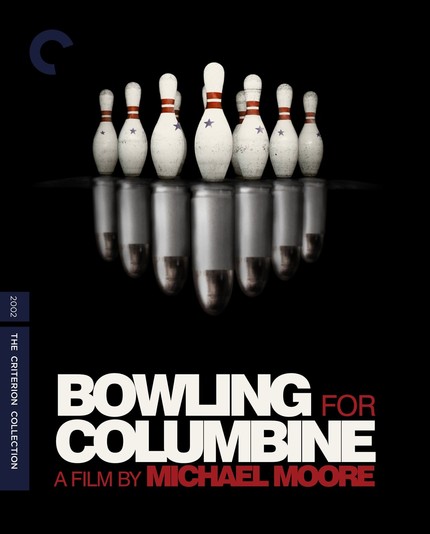Blu-ray Review: Criterion's BOWLING FOR COLUMBINE Throws a Strike
Michael Moore's Oscar-winning examination of America's gun violence epidemic resurfaces in high definition

While one could never claim that Michael Moore is nothing if not sincere, it’s hard to argue that it’s anything other than his sincerity that fuels his finer documentary/infotainments. Atop that shortlist stands his 2002 tragi-comic screed, Bowling for Columbine.
The film has a lot to say, far too much of it distressingly relevant in today’s world, all these many years later. Yet, in creating it, Moore demonstrates a certain objective openness to do the “documentary thing”, and go where his story takes him, as opposed to forcing his preconceived point. The kicker, then is this: Though a sharp shot into the well-stocked ammo closets of America, Michael Moore’s Bowling for Columbine is far beyond being a “gun control movie”.
It’s true that following the 1999 mass shooting at Columbine High School in Littleton, Colorado, the filmmaker set out to do what he could in the name of making his country safer from gun violence. Yet, as this two-hour tragi-comedy bit of wry investigative journalism unfolds, Moore follows a logic lead that surprises even him, an avowed (at the time) member of the National Rifle Association: Guns aren’t the real problem.
Certainly they’re a problem, what with their proliferation and ubiquitousness. But when Moore stumbles upon the fact that his beloved idealized utopia of a country, Canada, has a guns-to-homes ratio nearly equaling that of the United States, the film’s central mission of challenging American gun culture became one of asking why. Why, if Canada also has an absurd number of guns amid its general populace, don’t they have the mass shootings and gun violence that plague the U.S.?
In the words of the uncovered perpetrator, the answer may shock you... The American free press, it turns out, is found guilty of cultivating a “culture of fear”; from stirring up morbid curiosities to indulging in alarmist faux-reporting about “what you don’t know may kill you”, sensationalism is spoon fed to the people via TV news, radio, and online. But the widespread unnerving quality of it all sinks deeper than horse-crap special reports on supposed coming killer bee onslaughts and the lethal truth about escalators. One might say that it’s right there, in black and white... in full color, don’t touch that dial.
Yes, (spoiler alert) underlying racism is detailed to be at the heart of all of this, resulting in everything from the outright “othering” of blacks and other ethnic minorities to elimination by omission is most other aspects of the media. Though progress in these areas could certainly be claimed since Bowling’s 2003 release, the underlying cultural divides have arguably only grown more volatile. Moore’s conclusion here may not exactly be provable (it may even be borrowed), but the premise holds plenty of lead-free water: The news may not be “fake”, but it certainly isn’t good.
Moore’s style famously consists of him taking center stage as he examines his hot-button subject (or, in the case of Where to Invade Next?, multiple subjects) at hand. His schlubby, unkempt demeanor is key to his appeal as he travels from place to place meeting with and/or ambushing individuals important to his topic. Moore is sly about cultivating outrage-laden judgement against his targets, particularly when it comes to dealing with most of the targets themselves. His “in” is via his caucasian, bespectacled everyman presentation; just a Michigan boy trying to make it in the world, and make some sense of it.
It works: Throughout an hours-long sit-down at the home of James Nichols, the brother of Oklahoma City bomber Terry Nichols, the subject offers plenty of fodder for allegations of extremist gun-nut kookism. Nichols taking Moore into his bedroom to prove that he actually does sleep with a loaded gun under his pillow is one such moment that needs no amplification via editing to make the filmmaker’s point for him.
As a filmmaker, he’s succeeded at melding the skills of entertaining and informing. Moore has the rare ability to upshift/downshift from solid wry comedy to devastating real-world pathos, and back again, with no evidence of road-bumps from within his vehicle. His facts might be spotty at times, and his research is no doubt skewed, but when his films click, he can take you anywhere he wants to.
Unfortunately for him, his storytelling skills aren’t what he’s known for. Intensely popularized by this very movie, at least for a time, Moore couldn’t resist making the leap from being the world’s most populous activist filmmaker to an outspoken political pundit; a cult of personality unto himself.
Viewing the nearly thirty-minute video featurette in which Moore returns to Littleton six months after the release after Bowling for Columbine, a vintage DVD supplement from an earlier MGM release, included on this newly released Criterion Blu-ray edition, shows the path he chose: That of a political rock star. With the world’s admiration heaped upon Bowling for Columbine, the change to finally transcend the identity of “filmmaker”, and use his extended influence to take down then-President George W. Bush. Moore, at his cheering rally, was preaching to a very large choir, and loving every minute of his sudden demagoguery. Soon he’s signing books, effortlessly scoring major laughs and applause, and eating it up.
In the midst of it, at his book signing table, a teary eyed young lady makes her way to him, identifying herself as a survivor of the Columbine High School shooting attack that claimed the lives of twelve people in 1999. She thanks him for the film, for telling their story, and acting on their behalf. Clearly, Moore is moved, getting up from his seat to give her a hug. In that moment, the true “why” of his efforts visibly return. The hubris-propaganda supernova Fahrenheit 9/11 would immediately follow, a film that would be one step too far for this critic. In the subsequent years, though, Moore’s films would settle from being loud media bullhorns into less volatile works, often opening the door for his empathetic optimism to return to his own spotlight.
As Moore informs us, it all comes down to America being a culture of fear. And for good measure, he spends time with Culture of Fear author, Barry Glassner. They go to South Central, Los Angeles, a notoriously crime ridden area where white people are typically terrified for their lives. The greatest threat singled out in that moment? Smog. Smog, so dense that it’s blocking all visibility to the nearby Hollywood sign. No one, however, cares about that particular universal threat, including the police sergeant that Moore baits into a loaded exchange about the hypotheticals of arresting whomever is responsible for poisoning the air. The white sergeant, in need mood for this, feigns stepping away to investigate a black man innocently playing in his yard with a small child. Probably not the best course of action when it comes to avoiding Michael Moore on camera.
Joey Ramone’s cover of the immortal Louis Armstrong hit “What a Wonderful World” is a tremendously inspired choice for accompanying the closing credits. Not only does it reprise Armstrong’s version of the song (used earlier in the film to contrasting effect over disturbing material), it serves as a sort of tribute to Ramone himself, who succumbed to lymphatic illness. Moore and Ramone (an occasional activist in his own right) were on the same side of the political fence, making the song all the more fitting.
As far as activism-based documentary filmmaking goes, Bowling for Columbine is a case study in not only mass appeal, but stumbling into tragic longevity. That this 2002 film- released three whole years after the school shooting in its titular town- arrives on Blu-ray from Criterion in 2018 as more relevant than ever is a grotesque sadness.
In 2003, Bowling for Columbine took Best Documentary Feature at the Academy Awards. Moore’s memorably divisive acceptance speech is included as an extra on the Blu-ray, as well as other carry-overs from the old MGM DVD. New to this edition is a terrific little supplement called Michael Moore Makes a Movie, in which Moore and his collaborators look back at the making of Bowling, and discuss the director’s craft (as opposed to his politics). The 2002 Charlie Rose Show interview that is included, on the other hand, hyper focused on Moore’s politics. It’s boring, but it’s here. The printed essay is by Eric Hynes.
Criterion’s new high-definition digital restoration looks and sounds great, though certain scenes remain harsher looking than others. one can only assume that such inconsistencies are due to varying methods and/or conditions in which they were shot. On the whole, this new edition of Bowling for Columbine hits the necessary target more than ever - a fact that only underscores a degenerative reality of not just Moore’s America, but America itself.
Bowling for Columbine
Director(s)
- Michael Moore
Writer(s)
- Michael Moore
Cast
- Michael Moore
- Salvador Allende
- Jacobo Arbenz
- Mike Bradley








